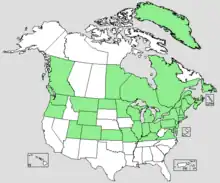Juncus gerardii
Juncus gerardii, commonly known as blackgrass, black needle rush or saltmarsh rush, is a flowering plant in the rush family Juncaceae.
| Juncus gerardii | |
|---|---|
 | |
| Scientific classification | |
| Kingdom: | Plantae |
| Clade: | Tracheophytes |
| Clade: | Angiosperms |
| Clade: | Monocots |
| Clade: | Commelinids |
| Order: | Poales |
| Family: | Juncaceae |
| Genus: | Juncus |
| Species: | J. gerardii |
| Binomial name | |
| Juncus gerardii | |
 | |
Distribution
Juncus gerardii is mainly a coastal species, occurring at the high tide mark on the Mediterranean, Atlantic, Baltic and Black sea shorelines of Europe and the east coast of North America Juncus gerardii is one of the many species identified by Eric Hultén as amphi-Atlantic plants, meaning that they have a disjunct distribution on both sides of the Atlantic, but are absent on the Pacific side of the globe.[1]: 172 It also occurs inland in parts of eastern Europe, west and central Asia, particularly on saline soils. In North America it occurs along the shorelines of areas once flooded by the sea, and as a weed along railway lines, for example in Minnesota.[1] In Indiana, it is the only Juncus species found in the Tipton Till Plain, a Till Plain in the Glacial till plains.[2]
References
- Hultén, Eric. The amphi-Atlantic plants and their phytogeographical connections. Stockholm, Sweden: Almqvist & Wiksell.
- Lamerson, Virginia (1950). "Coastal plains flora in Indiana botanical areas". Butler University Botanical Studies. 9 (1): 188–196.